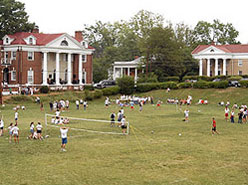 It was a Sunday afternoon at a University of Virginia fraternity house located in a cluster of frat houses that overlooked an intramural field depression known as “Mad Bowl” when I met Bob Dylan and witnessed him rejected as a folk singer and song writer.
It was a Sunday afternoon at a University of Virginia fraternity house located in a cluster of frat houses that overlooked an intramural field depression known as “Mad Bowl” when I met Bob Dylan and witnessed him rejected as a folk singer and song writer.
The year was 1961, and Dylan had been brought to the fraternity house by folk singer, folklorist, and mentor Paul Clayton who had friends there. Clayton was a UVA grad with a master’s degree in folklore. Since the mid-1950s, Clayton had traveled the Southern Appalachian Highlands in search of traditional folksongs that were in danger of extinction. As a scholar and archivist, he recorded these treasures on site and then sang many of them himself on 21 albums released between 1954 and 1965. In folk music circles from New York City to Los Angeles, Paul Clayton was a prominent figure in the folk music revival of the 1950s and 1960s.
 Clayton’s purpose on that Sunday afternoon was to have newcomer Bob Dylan and recorded folk singer Carolyn Hester sing a few songs as a measure of their live performance abilities. It was easy to pull the frat boys away from the ball game on television once they got an introduction to Carolyn Hester. She was 24 years old at the time and Hollywood gorgeous. Hester had already released two albums and was being compared to folk music star Joan Baez. Clayton was helping her with her live performance guitar playing, which was weak at the time. Hester stood against the living room wall and performed two unremembered songs. Her singing was strong and beautiful, but she missed some chords in the accompaniment.
Clayton’s purpose on that Sunday afternoon was to have newcomer Bob Dylan and recorded folk singer Carolyn Hester sing a few songs as a measure of their live performance abilities. It was easy to pull the frat boys away from the ball game on television once they got an introduction to Carolyn Hester. She was 24 years old at the time and Hollywood gorgeous. Hester had already released two albums and was being compared to folk music star Joan Baez. Clayton was helping her with her live performance guitar playing, which was weak at the time. Hester stood against the living room wall and performed two unremembered songs. Her singing was strong and beautiful, but she missed some chords in the accompaniment.
Clayton then encouraged the shy, downcast, tousle headed, disheveled 20-year-old Bob Dylan to uncase his guitar and sing a couple of his original songs. Perhaps in over 50 years of retrospect it is wishful thinking, but I swear that one of the songs that he performed was “Blowin’ in the Wind.” Although Dylan would become “the voice of his generation,” his singing voice has been described as, “raw, seemingly untrained, and frankly a nasal voice” by Joyce Carol Oates among others. Dylan was also accused of imitating Woody Guthrie’s earthy vocal mannerisms which were also termed “iconoclastic baying.”

Mad Bowl, UVA
The frat boys that Sunday found Dylan’s singing to be both incomprehensible and downright irritating. Someone turned the television set back on to the ball game, and there were insincere smiles and gestures that communicated to the performers that their leave taking was in order. Clayton’s fraternity friend made an awkward apology as the three folk singers exited the scene of their embarrassment.
Soon after the fraternity house debacle, Carolyn Hester invited Bob Dylan to play harmonica on sessions for her third album at Columbia Records. At a rehearsal session, Dylan met celebrated record producer John Hammond who signed him to a recording contract. Dylan’s first album on Columbia Records was released on March 19, 1962. The album made a great impression in the folk music community, but it was not commercially successful.
invited Bob Dylan to play harmonica on sessions for her third album at Columbia Records. At a rehearsal session, Dylan met celebrated record producer John Hammond who signed him to a recording contract. Dylan’s first album on Columbia Records was released on March 19, 1962. The album made a great impression in the folk music community, but it was not commercially successful.

Dylan’s second album The Freewheelin’ Bob Dylan, released in May 1963, however, featured “Blowin’ in the Wind” as its first cut. If Dylan could not make his songs famous, then cover groups like Peter, Paul and Mary, The Byrds, Sonny and Cher, The Hollies, and many others could. The Beatles themselves reported listening to the Freewheelin’ album until they wore it out.
Since being rejected by the UVA frat boys in 1961, Bob Dylan has sold more than 100 million records. No songwriter, past or present, has received so many awards and honors. A partial list includes The Grammy Lifetime Achievement Award (1991), The Kennedy Center Honor (1997), an Academy Award Oscar for Best Song (2001), the Pulitzer Prize (2008), the Presidential Medal of Freedom (2012), and the Nobel Prize for Literature (2016).
There are perhaps a dozen men now into their 70s who may remember Bob Dylan from their fraternity house encounter in 1961. Fortunately, their rejection of the young artist did not kill his creative spirit. What if they had encouraged him? No telling to what heights he might have risen then.
